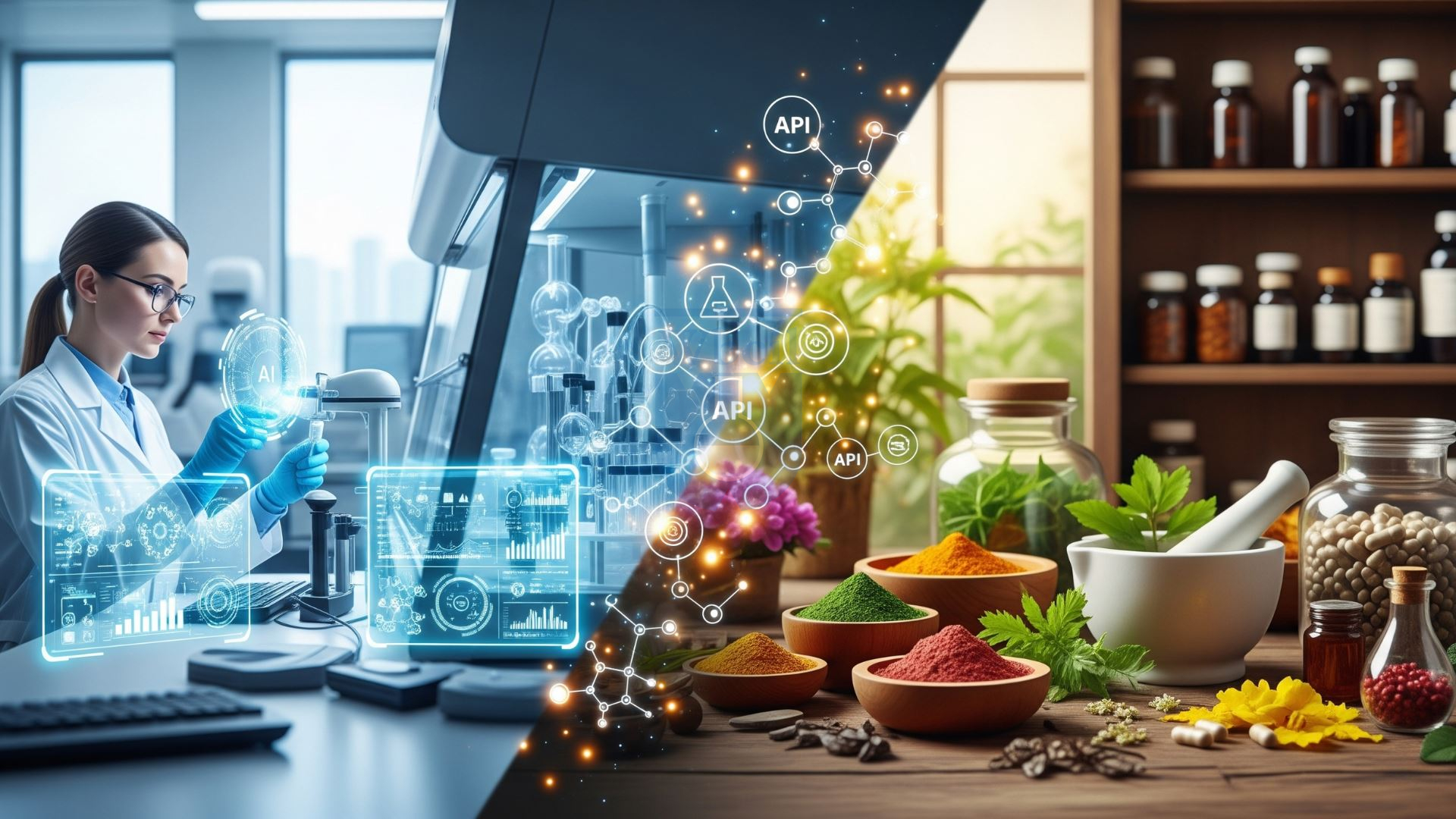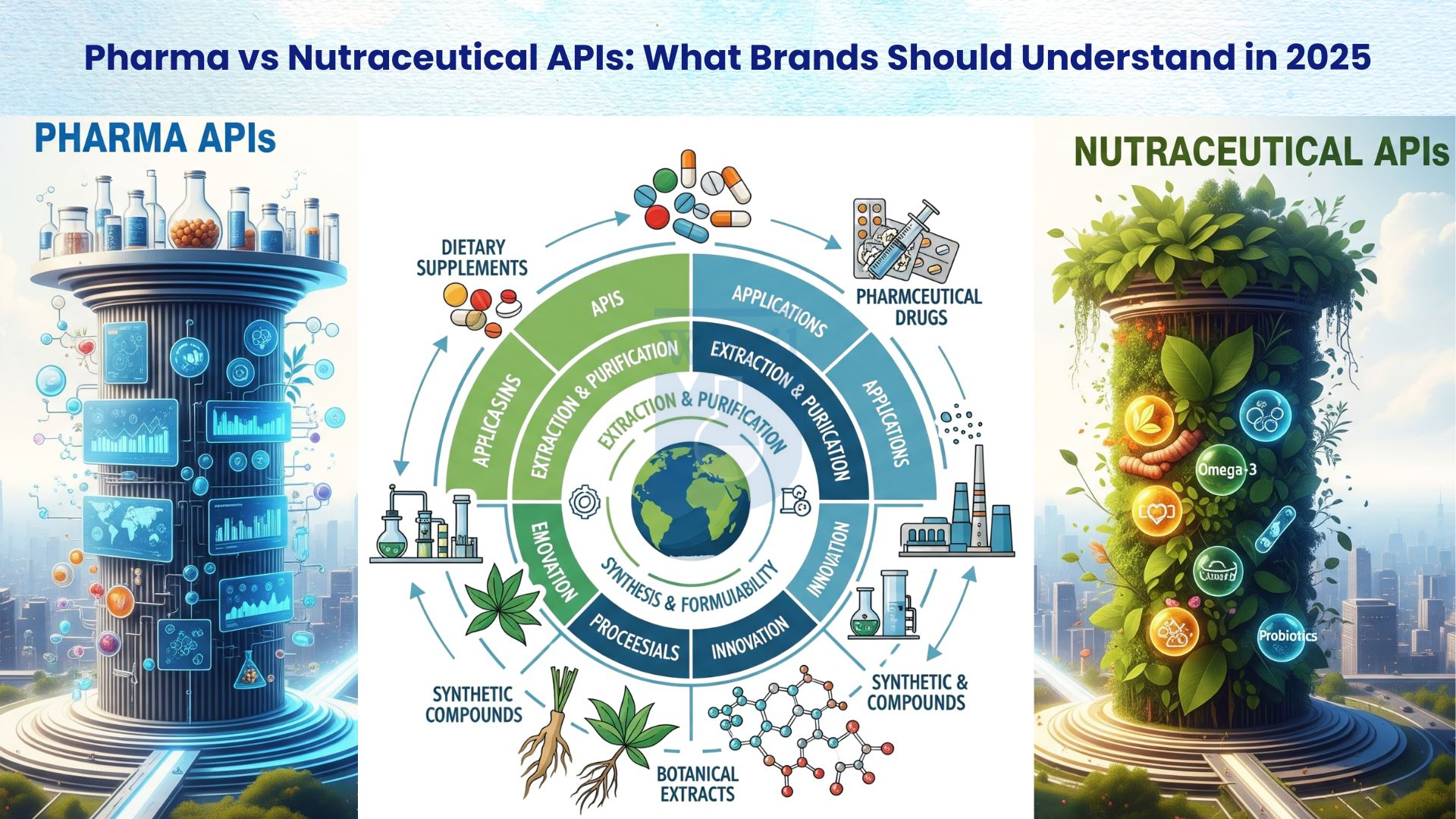Pharma vs Nutraceutical APIs: What Brands Should Understand in 2025
Introduction: A Tale of Two Pillars in the Health Revolution
Picture the health and wellness space as a vibrant city, teeming with innovation and potential. At its center are two giant pillars: pharma APIs and nutraceutical APIs, each holding up different but complementary domains of human health.
The international health and wellness market, set to rocket well over USD 7 trillion by 2025, feeds on consumers’ appetite for reliable, science-supported answers. Companies working within this dynamic space need to appreciate the distinction between pharma APIs and nutraceutical APIs in order to develop products that appeal to sophisticated consumers.
Pharma APIs are the high-performance engines of contemporary medicine, fueling therapeutic success with uncompromising precision. Conversely, nutraceutical APIs are nature’s craftsmen, spinning health from natural ingredients to enhance wellness and prevention. The two paradigms have varying regulatory environments, manufacturing intricacies, and market possibilities, particularly as we enter 2025.
This blog post is your guide, shedding the distinction between pharma APIs and nutraceutical APIs, enabling responsible choices in sourcing, manufacturing, and market strategies.

Defining the Landscape: Pharma APIs
Pharma APIs, or Active Pharmaceutical Ingredients, are the pulse of prescription and over-the-counter medications. These bioactive ingredients are the biologically active molecules that cause a drug’s medicinal effect—to treat a headache, to cure an infection, or to control long-term conditions such as diabetes. Compare pharma APIs to the spark that makes a drug heal. Common ones are ibuprofen for pain, metformin for diabetes, and penicillin for infections. All pharma APIs are carefully crafted to produce clinical-grade ingredients with accuracy, ensuring safety and efficacy for patients globally.
The Stringent Regulatory Environment for Pharma APIs in 2025
Countering the regulatory environment for pharma APIs is similar to navigating through a storm with a compass riveted by worldwide agencies like the FDA (US), EMA (Europe), and WHO. These organizations impose rigorous manufacturing regulations, with Good Manufacturing Practices (GMP) being the cornerstone of compliance. In 2025, look for increased scrutiny, with strengthened GMP standards focusing on data integrity, tougher facility audits, and more advanced serialization for traceability. Pharma APIs need heavy documentation, intensive clinical trials to establish efficacy and safety, and strong post-market surveillance to track long-term impact. This regulatory stronghold guarantees pharma APIs adhere to the highest quality and patient safety benchmarks, making API providers for pharmaceuticals essential partners in compliance.
Manufacturing Complexities and Quality Control
Pharma API manufacturing is similar to creating a masterpiece in a state-of-the-art laboratory. API production incorporates multi-step chemical synthesis, fermentation, or next-generation biopharmaceutical API manufacturing processes. Pharmaceutical-grade purity, consistency, and stability are required at every stage. Stringent testing—covering raw materials, in-process, and finished products—is needed to ensure identity, potency, and purity with impurities profiling, residual solvents, and heavy metals. New technologies, including continuous flow chemistry and AI/ML-enabled real-time monitoring, are revolutionizing pharma, API manufacturing, lowering errors and increasing efficiency.
The significant R&D and pharma contract
manufacturing investment highlights the sophistication of producing pharma APIs to international standards.
Strolling through the Nutraceutical World: Nutraceutical APIs
Nutraceutical APIs are the colors of the dietary supplement and functional foods world, bringing health benefits beyond ordinary nutrition. In contrast to pharma APIs, which address diseases, nutraceutical ingredients provide wellness and prevention. From natural origins, these bioactive compounds consist of vitamins, minerals, herbal extracts such as curcumin, omega-3 fatty acids, and probiotics. Imagine nutraceutical APIs as nature’s elixir, condensed to give one more vitality.
Though not drugs, they have a central function in the increasing trend towards overall health solutions, so nutraceutical API providers to supplement makers derive their importance from this area.
The Changing Regulatory Landscape for Nutraceutical APIs in 2025
The regulatory environment for nutraceutical APIs is a pliable garden rather than the impenetrable fortress of pharma APIs. As dietary supplements or foods, nutraceutical APIs have less stringent regulation, with emphasis on general sanitation and overall GMP practices.
They don’t have pre-market approval for efficacy, as pharma APIs do, but claims and labeling are subject to regulation in order not to mislead the consumer. In 2025, growing market size and issues of quality drive closer scrutiny, with regulators prioritizing transparency and safety. Brands that use nutraceutical APIs need to remain alert to keep up with changing standards and establish customer trust.
Manufacturing and Quality Concerns
Manufacturing nutraceutical APIs is distilling nature’s flavor without losing its essence. Operations such as extraction, purification, and concentration seek to retain the natural characteristics of nutraceutical ingredients. In contrast to zero-tolerance accuracy in pharma APIs, nutraceutical APIs allow for variability in natural sources, e.g., botanical extracts. Quality control emphasizes detection of contaminants (microbiological, heavy metals), identity verification, and determination of minimum potency. Although GMPs are in place, testing is not as comprehensive as for pharma APIs, as the food-grade or dietary supplement-grade requirements. New technologies such as liposomal nutraceuticals improve bioavailability, rendering nutraceutical APIs more effective and desirable.

Overlapping Zones and Key Differences Regulatory Compliance: A Tale of Two Standards
What distinguishes pharma APIs from nutraceutical APIs is their purpose and regulation. Pharma APIs are designed for cure and treatment, subjected to comprehensive clinical trials and detailed dossiers before approval. Nutraceutical APIs, aimed at health support and prevention, emphasize general safety and labeling accuracy, and involve less documentation. Post-market surveillance of pharma APIs is strict to maintain patient safety, whereas nutraceutical APIs are subject to increasing but less stringent monitoring. Knowing the differences between nutraceutical APIs and pharmaceutical APIs is essential for brands managing compliance in 2025.
Manufacturing Precision and Quality Control
The pharma API manufacturing process requires virtual zero tolerance for variation, achieving pharmaceutical-grade purity through rigorous validation and analytical testing (e.g., impurity profiling). Nutraceutical APIs permit limited variation with natural raw material differences, meeting food-grade or dietary supplement-grade specifications. Both must be controlled for quality, but pharma APIs are subjected to wider, more stringent testing to ensure consistency and safety because of their pivotal role in drug efficacy.
Supply Chain Dynamics and Sourcing
Pharma APIs and nutraceutical APIs both depend on international supply chains, but while pharma API sourcing is focused on certified, audited pharmaceutical ingredient suppliers, traceability is legally required for pharma APIs for patient safety, and becoming increasingly adopted by nutraceutical APIs on a voluntary basis. Cold chain logistics are crucial to sensitive biopharmaceutical API manufacture, and coming on stream for some nutraceutical ingredients such as probiotics. Risk Mitigation—via multi-sourcing, safety stock, and real-time visibility—is essential for both, but particularly stringent for pharma APIs because they affect health outcomes.
Cost Implications and Market Access
The advantages of pharma APIs in drug production are met with high R&D and manufacturing expenditure because of stringent testing and compliance. Nutraceutical APIs, having fewer regulatory barriers, provide quicker market availability and lower costs, thus being more cost-friendly. Pharma APIs tend to fetch premium prices due to patents and established efficacy, but nutraceutical APIs attract price-sensitive consumers who look for prevention-oriented health solutions. API contract manufacturing and pharma-grade API providers have a crucial role to play in striking cost versus quality balance between both these industries.
Market Trends and Opportunities in 2025
Pharma API Market Outlook
Pharma API market is a behemoth and is expected to grow to USD 246.41 billion in 2025 at a CAGR of 6.7% from 2029. Aided by an escalation in the rate of chronic diseases, growth in R&D spend, and technological advancements in APIs, the industry is set to grow. Top trends are digitalization of drug development, AI/ML in drug discovery, and emphasis on rare diseases and biosimilars.
Asia Pacific, and China and India specifically, are at the forefront of global API manufacturing trends with cost-effective production and readily available skilled labor.
Suppliers of pharmaceutical ingredients and pharmaceutical API suppliers are capitalizing on opportunities to fulfill increasing demand.
Nutraceutical API Market Outlook
The plant-based API segment of the nutraceutical API market is worth USD 36.24 billion in 2025 and is expected to grow at a CAGR of 6.7% until 2037. Consumers’ increasing interest in natural, holistic health products and innovations in nutraceutical ingredients (e.g., clean-label APIs, personalized nutrition) drive this growth. Sustainability, new delivery systems (e.g., liposomal nutraceuticals), and scientific substantiation of benefits are redefining the market. Brands utilizing bulk API supply for nutraceutical brands are able to access niche markets through emphasis on transparency and quality.
The Blurring Lines: Hybridization and Future Directions
The boundary between pharma APIs and nutraceutical APIs is dissolving, and “medical foods” and hybrid products are filling the gaps. Nutraceutical ingredients are being invested in by pharma companies, while nutraceutical brands are embracing science- based methods for building credibility. This overlap presents brands with opportunities to innovate by putting together the specificity of pharma APIs and the accessibility of nutraceutical APIs to deliver products that speak to health-oriented consumers.
Strategic Considerations for Brands in 2025
Sourcing and Supplier Selection
Selecting the appropriate pharmaceutical ingredient vendors or nutraceutical API vendors by supplement manufacturers is similar to choosing a good guide for a dangerous expedition. For pharma APIs, suppliers should be given high importance with GMP certification and regulatory compliance. For nutraceutical APIs, organic certifications, transparency, and strict internal quality control are important. Supplier audits and due diligence are non-negotiable to meet brand values and consumer trust in ensuring nutraceutical API sourcing.
Quality Assurance and Risk Management
A solid quality management system (QMS) forms the pillar of success for both pharma APIs and nutraceutical APIs. Systematic testing procedures—verifying identity, purity, strength, and safety—are imperative. Brands need to establish strong supply chains to insulate against disruptions, especially for pharma APIs, with patient safety as the highest priority. Pharmaceutical contract manufacturing and API contract manufacturing collaborators can strengthen quality assurance through cutting-edge technology and know-how.
Regulatory Compliance and Labeling
Being ahead of manufacturing regulations is essential in 2025. For pharma APIs, there are complicated drug approval procedures to navigate, and for nutraceutical APIs, there are substantiated claims and compliant labeling to prevent legal traps. Regulatory investment guarantees brands’ flexibility in a changing environment, protecting compliance as well as consumer trust.
Conclusion: Charting the Path Forward
In the active health and well-being city of 2025, pharma APIs and nutraceutical APIs are twin pillars with different strengths and challenges. Pharma APIs have precision and therapeutic efficacy, supported by strict regulation and sophisticated manufacturing. Nutraceutical APIs have affordable, natural approaches, with increasing scrutiny and innovation. Success depends on knowing the distinction between pharma APIs and nutraceutical APIs, strategic sourcing from pharma-grade API manufacturers and nutraceutical API manufacturers, and an absolute commitment to quality. Brands that are attuned to these differences will excel, providing products that enable health and create trust. Use this expertise to successfully navigate 2025 and propel sustainable growth.
